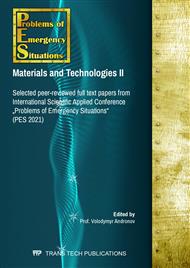[1]
F. IKhan, S.AAbbasi, An assessment of the likelihood of occurrence, and the damage potential of domino effect (chain of accidents) in a typical cluster of industries, Journal of Loss Prevention in the Process Industries. 14(4) (2001) 283-306.
DOI: 10.1016/s0950-4230(00)00048-6
Google Scholar
[2]
Otrosh, Y., Kovalov, A., Semkiv, O., Rudeshko, I., Diven, V. (2018). Methodology remaining lifetime determination of the building structures. MATEC Web of Conferences, 230, 02023.
DOI: 10.1051/matecconf/201823002023
Google Scholar
[3]
S. Hope, B. W. Eddershaw, L. Joanny and others Methodologies for hazard analysis and risk assessment in the petroleum refining and storage industry, Fire Technology 20(3) (1984) 23-38.
DOI: 10.1007/bf02389992
Google Scholar
[4]
Vasilchenko Alexey, Doronin Evgeny, Ivanov Boris, Konoval Vladimir, Effect of residual deformation of a steel column on its fire resistance under combined exposure explosion-fire,, Materials Science Forum. 968, (2019) 288-293.
DOI: 10.4028/www.scientific.net/msf.968.288
Google Scholar
[5]
Pettersson O. Practical need of scientific material models for structural fire design, Fire Safety Journal 13(1) (1988) 1-8.
DOI: 10.1016/0379-7112(88)90027-6
Google Scholar
[6]
Pozdieiev S., Nuianzin O., Sidnei S., Shchipets S. Computational study of bearing walls fire resistance tests efficiency using different combustion furnaces configurations (2017) MATEC Web of Conferences, 116, art. no. 02027.
DOI: 10.1051/matecconf/201711602027
Google Scholar
[7]
B. Li , 1 Y. Q. Lin,1 H. L. Zhang,2 and M. J. Ma, Fire Behavior of the Assembled Monolithic Hollow-Ribbed Slabs, Advances in Civil Engineering Volume 2019, Article ID 8921502, 10.
DOI: 10.1155/2019/8921502
Google Scholar
[8]
Rickard Augustsson, Markus Härenstam, Design of reinforced concrete slab with regard to explosions, Department of Civil and Environmental Engineering Division of Structural Engineering Concrete structures, Chalmers university of technology, Göteborg, Sweden, (2010).
Google Scholar
[9]
Mario Bermejo1, Jose M. Goicolea, Felipe Gabaldon and Anastasio Santos, Impact and explosive loads on concrete buildings using shell and beam type elements, COMPDYN 2011. 3rd ECCOMAS Thematic Conference on Computational Methods in Structural Dynamics and Earthquake Engineering. Corfu, Greece, 25-28 May (2011).
Google Scholar
[10]
Mamoun A Alqedra, Mohammed H. Arafa and Mahmod Shaheen, Behavior of Normal and High Strength Reinforced Concrete Structures under Blast Loading, Trends in Civil Engineering and its Architecture 2(1) 2018. TCEIA.MS.ID.000127.
DOI: 10.32474/tceia.2018.02.000127
Google Scholar
[11]
Gianluca Iannitti, Nicola Bonora, Stefano De Muro, Analysis of reinforced concrete slabs under blast loading, Procedia Structural Integrity 9 (2018) 272-278.
DOI: 10.1016/j.prostr.2018.06.035
Google Scholar
[12]
Roytman V.V., Pasman H.J., Lukashevich I.E. The Concept of Evaluation of Building Resistance against combined hazardous Effects Impact-Explosion-Fire, after Aircraft Crash, Fire and Explosion Hazards: Proceedings of the Fourth International Seminar. 2003, Londonderry, NI, UK. 283-293.
Google Scholar
[13]
F. Kadri, E. Chatelet, Domino Effect Analysis and Assessment of Industrial Sites: A Review of Methodologies and Software Tools, International Journal of Computers and Distributed Systems 02 (III) 2013 1-10.
Google Scholar
[14]
Kovalov, A., Otrosh, Y., Ostroverkh, O., Hrushovinchuk, O., Savchenko, O. (2018). Fire resistance evaluation of reinforced concrete floors with fire-retardant coating by calculation and experimental method. E3S Web of Conferences, 60, 00003.
DOI: 10.1051/e3sconf/20186000003
Google Scholar
[15]
Kumpyak O.G. and others, Reinforced concrete and stone structures: textbook M.: Publishing house ASV, (2011).
Google Scholar
[16]
V.N. Demekhin, I.L. Mosalkov, G.F. Plyusnina and others. Buildings, structures and their resistance in case of fire. Moscow, Academy of State Fire Service of the Ministry of Emergencies of Russia, (2003).
Google Scholar
[17]
Zaikin A.I., Design of reinforced concrete structures for multi-storey industrial buildings. Moscow: ASV, (2005).
Google Scholar
[18]
Broms B.B. and Lutz L.A. Crack Width and Crack Spacing in Reinforced Concrete Members, J.ACJ Jornal (1965) 62(10) 20.
DOI: 10.14359/7742
Google Scholar
[19]
Utkin V.S., Utkin L.V. Determination of the reliability of reinforced concrete elements in the presence of force cracks in them, normal to the longitudinal axis. Concrete and reinforced concrete. (1999) 5 15-16.
Google Scholar
[20]
B. R. B. Recalde, F. P. S. L. Gastal, Numerical analysis of waffle slabs in flexure considering the effects of concrete cracking, Revista IBRACON de Estruturas e Materiais 2015 8(2) 225-247.
DOI: 10.1590/s1983-41952015000200009
Google Scholar


